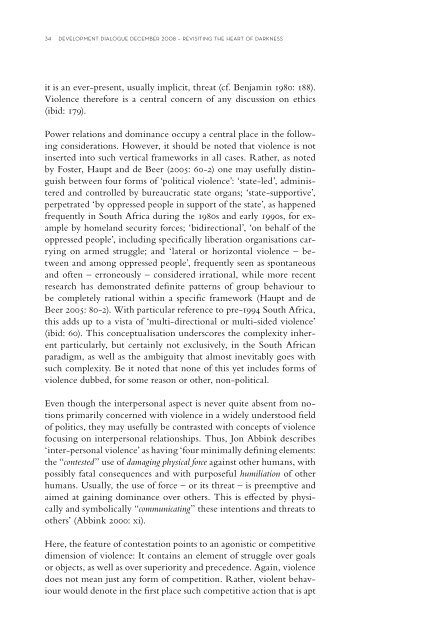60 years after the UN Convention - Dag Hammarskjöld Foundation
60 years after the UN Convention - Dag Hammarskjöld Foundation
60 years after the UN Convention - Dag Hammarskjöld Foundation
Create successful ePaper yourself
Turn your PDF publications into a flip-book with our unique Google optimized e-Paper software.
34 development dialogue december 2008 – revisiting <strong>the</strong> heart of darkness<br />
it is an ever-present, usually implicit, threat (cf. Benjamin 1980: 188).<br />
Violence <strong>the</strong>refore is a central concern of any discussion on ethics<br />
(ibid: 179).<br />
Power relations and dominance occupy a central place in <strong>the</strong> following<br />
considerations. However, it should be noted that violence is not<br />
inserted into such vertical frameworks in all cases. Ra<strong>the</strong>r, as noted<br />
by Foster, Haupt and de Beer (2005: <strong>60</strong>-2) one may usefully distinguish<br />
between four forms of ‘political violence’: ‘state-led’, administered<br />
and controlled by bureaucratic state organs; ‘state-supportive’,<br />
perpetrated ‘by oppressed people in support of <strong>the</strong> state’, as happened<br />
frequently in South Africa during <strong>the</strong> 1980s and early 1990s, for example<br />
by homeland security forces; ‘bidirectional’, ‘on behalf of <strong>the</strong><br />
oppressed people’, including specifi cally liberation organisations carrying<br />
on armed struggle; and ‘lateral or horizontal violence – between<br />
and among oppressed people’, frequently seen as spontaneous<br />
and often – erroneously – considered irrational, while more recent<br />
research has demonstrated defi nite patterns of group behaviour to<br />
be completely rational within a specifi c framework (Haupt and de<br />
Beer 2005: 80-2). With particular reference to pre-1994 South Africa,<br />
this adds up to a vista of ‘multi-directional or multi-sided violence’<br />
(ibid: <strong>60</strong>). This conceptualisation underscores <strong>the</strong> complexity inherent<br />
particularly, but certainly not exclusively, in <strong>the</strong> South African<br />
paradigm, as well as <strong>the</strong> ambiguity that almost inevitably goes with<br />
such complexity. Be it noted that none of this yet includes forms of<br />
violence dubbed, for some reason or o<strong>the</strong>r, non-political.<br />
Even though <strong>the</strong> interpersonal aspect is never quite absent from notions<br />
primarily concerned with violence in a widely understood fi eld<br />
of politics, <strong>the</strong>y may usefully be contrasted with concepts of violence<br />
focusing on interpersonal relationships. Thus, Jon Abbink describes<br />
‘inter-personal violence’ as having ‘four minimally defi ning elements:<br />
<strong>the</strong> “contested” use of damaging physical force against o<strong>the</strong>r humans, with<br />
possibly fatal consequences and with purposeful humiliation of o<strong>the</strong>r<br />
humans. Usually, <strong>the</strong> use of force – or its threat – is preemptive and<br />
aimed at gaining dominance over o<strong>the</strong>rs. This is eff ected by physically<br />
and symbolically “communicating” <strong>the</strong>se intentions and threats to<br />
o<strong>the</strong>rs’ (Abbink 2000: xi).<br />
Here, <strong>the</strong> feature of contestation points to an agonistic or competitive<br />
dimension of violence: It contains an element of struggle over goals<br />
or objects, as well as over superiority and precedence. Again, violence<br />
does not mean just any form of competition. Ra<strong>the</strong>r, violent behaviour<br />
would denote in <strong>the</strong> fi rst place such competitive action that is apt

















